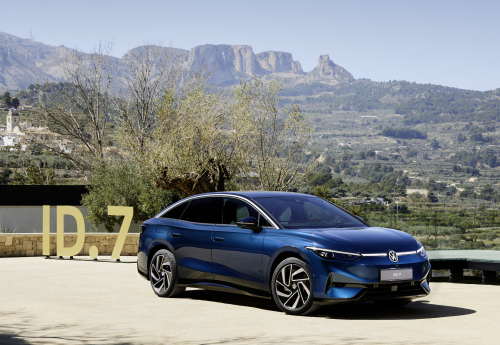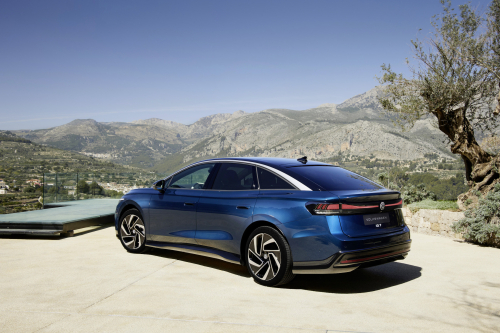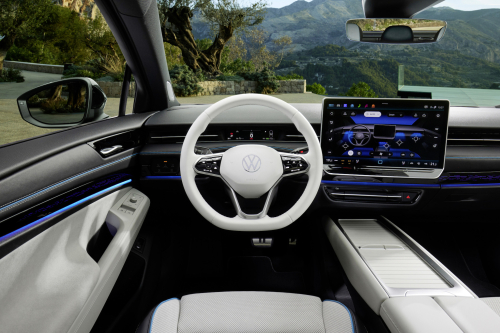
The ID.7 also makes its debut as the first Volkswagen with a standard augmented reality head-up display. Volkswagen plans to produce the new ID.7 for Europe and North America in the electric mobility plant in Emden.
With an aerodynamic design (drag coefficient of approximately 0.23 depending on equipment) that is 195.3 inches long, the car has a new efficient drivetrain generation that delivers an output of 282 horsepower (210 kW).
The ID.7 will be launched in Europe in two equipment and drive versions—Pro and Pro S—and is the first MEB model to be equipped with a drivetrain that has been newly developed by Volkswagen.

The system essentially consists of a 282-hp PSM permanent magnet synchronous motor, the two-stage 1-speed gearbox, and the inverter (power and control electronics). The increased power and efficiency of the electric drive motor in the ID.7 are the result of details such as a rotor with stronger permanent magnets that offer high thermal load capacity; a further-developed stator with a larger effective number of windings in combination with maximum wire cross-section; a water heat sink for the outside of the stator; and a new, combined oil and water cooling system that also ensures high thermal stability.
The thermal stability is safeguarded by a new inverter generation, and the high thermal load capacity is an elementary contributing factor to the increased efficiency of the new drivetrain. Numerous low-friction gearbox components have also been reinforced to withstand the high power and torque.
There will be two battery versions: the ID.7 Pro will have a 77 kWh battery (gross: 82 kWh), with DC fast-charging capability of up to 170 kW. The ID.7 Pro S (to be introduced at a later date for Europe) will be equipped with the latest Volkswagen battery with an energy content of 86 kWh (gross: 91 kWh) and up to 200 kW DC fast-charging capability. A new thermal management system preconditions the battery before a charging stop. This preconditioning starts automatically on the way to every charging station when route guidance is active.

Volkswagen will offer Park Assist Pro with Memory Function6 as optional equipment for the ID.7, including three automated modes that can be activated depending on the situation. A feature of Volkswagen’s electric vehicles is the memory function. With this, the ID.7 continuously records the last 165 feet driven and thus the parking situation. The parking maneuver can be stored when the ID.7 has come to a stop.
When the Volkswagen reaches the same position again—for example, the entrance to a home garage—the ID.7 automatically offers to take over parking independently. The driver either remains in the vehicle or monitors the procedure from outside the vehicle with their smartphone. Independent driving out of a parking space is also possible—in this case over a distance of up to 81 feet.
The standard Park Assist mode is a system that is already familiar from other Volkswagen models. This allows assisted driving into or out of parallel or bay parking spaces. The ID.7 takes over control of acceleration, braking and steering for this purpose. The third mode allows the driver to drive the vehicle into and out of parking spaces from outside the vehicle in the same situations. The driver controls the procedure using an app on their smartphone in this case. Within certain parameters, this is classed as an SAE Level 2 feature.
Vehicle and swarm data merge. The latest development of Travel Assist6 with swarm data7 (Europe only, currently) permits assisted driving of the ID.7 with assisted longitudinal and lateral control: on multi-lane highways, it also does so for assisted lane changing from speeds of 56 mph. Adaptive lane guidance is another function that has been enhanced. Whereas Travel Assist previously relied on at least one visible lane boundary marking for lateral guidance, features such as curbs are now sufficient for the system.
The fusion of the vehicle data with the swarm data of other vehicles is another new feature. As an example, the ID.7 detects speed limits by camera and navigation data and integrates them into the assisted longitudinal control function of Travel Assist so that the vehicle independently observes the limits. In addition, the system can also register parameters such as bends, roundabouts and junctions that are located ahead and incorporate them into predictive control.
The ID.7 receives information about speed limits further along the route by means of the map data and swarm data from vehicles driving in front. Since all signals of the vehicle and the available swarm data are used, the new Travel Assist generation offers especially smooth and predictive control.
Assisted lane changing. The swarm data is also used for assisted lane changing when driving on multi-lane highways (late introduction). However, these lane changes—just like assisted lateral and longitudinal control—also function without swarm data. Travel Assist visually offers the driver a lane change if this is permitted by the traffic ahead. If the driver then taps the turn signal of the ID.7, an assisted lane change is performed within the limits of the system as long as the driver is touching the steering wheel. The driver remains responsible for vehicle control here as well.